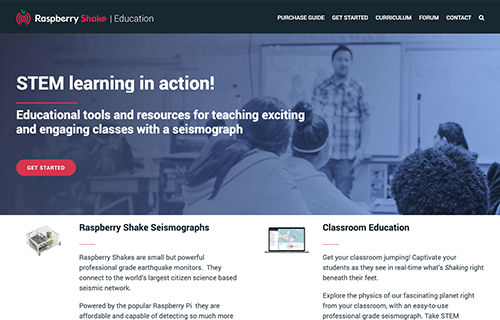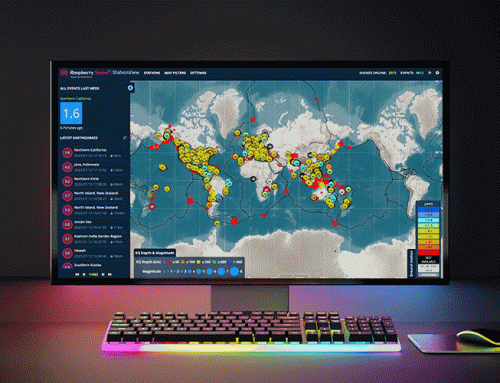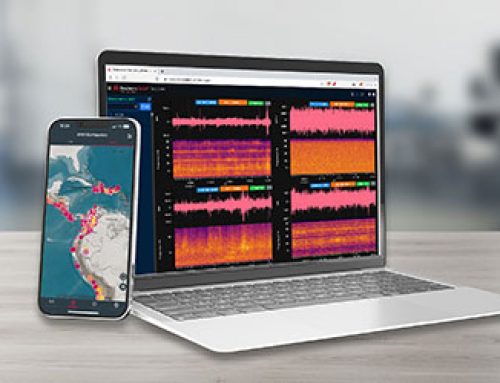SHAKE EDUCATION IS HERE!
08 October, 2019 – Written by Gabriel Low, Raspberry Shake Educational Designer
Hola Shakers!
Gabriel Low here! – I’m the Educational Designer for Raspberry Shake, down in Panama.
Our team has been working hard over the last few months to put together a new resource for Shake Educators – arguably one of our most powerful tools yet – our new education website, dedicated to inspiring the next generation of scientists and engineers using Raspberry Shake!
Ever since the Raspberry Shake project began, more than three years ago now, our team has been inspired time and time again by the power of our little seismograph in education.
Programs like Oklahoma’s BLOSSM initiative, Seismology at School in Nepal, Indonesia’s StIRRRD SIS project, Texas’ TXESP, (the list goes on!) are all an inspiration and an incredible testament that shows the power of Shakes in the classroom. Not only have these projects achieved real learning, but they have gone a step further: empowering students and their communities by raising awareness and becoming a part of something bigger — by contributing to a real live global seismic network.

Teaching at a Raspberry Shake workshop in Fairbanks, Alaska
Over the past year we have been actively involved in multiple Raspberry Shake educational workshops which have helped us test and build teaching resources that use our seismographs. Throughout the process we have also been in collaboration with existing programs (like the ones mentioned above) whose input has been vital to building the Shake Education initiative. Now, we are very proud to announce the launch of edu.raspberryshake.org — a complete educational resource for educators to get Shaking in the classroom.
Educator or not, the site contains materials and resources for all Shakers to get excited about. Continue reading to learn more about our new education dedicated website!
KEY FEATURES
The website has been broken down into four main sections:
- Purchase Guide: Recommendations and resources to get Shakes into your classroom, including funding ideas
- Get Started: Education-specific step-by-step instructions and tips for setting up and using your Shake
- Curriculum: Start teaching with Raspberry Shake – example lesson plans and exercises to get your students Shaking
- Forum: A dedicated educators forum to connect with other teachers shaking all around the world
Let’s take a closer look!
PURCHASE GUIDE
Getting access to teaching tools, equipment and resources can sometimes be a challenge all of its own, with each educational facility often having their own unique acquisition protocols. The Purchase Guide aims to facilitate this process, and get Shakes in your classroom quickly and easily.
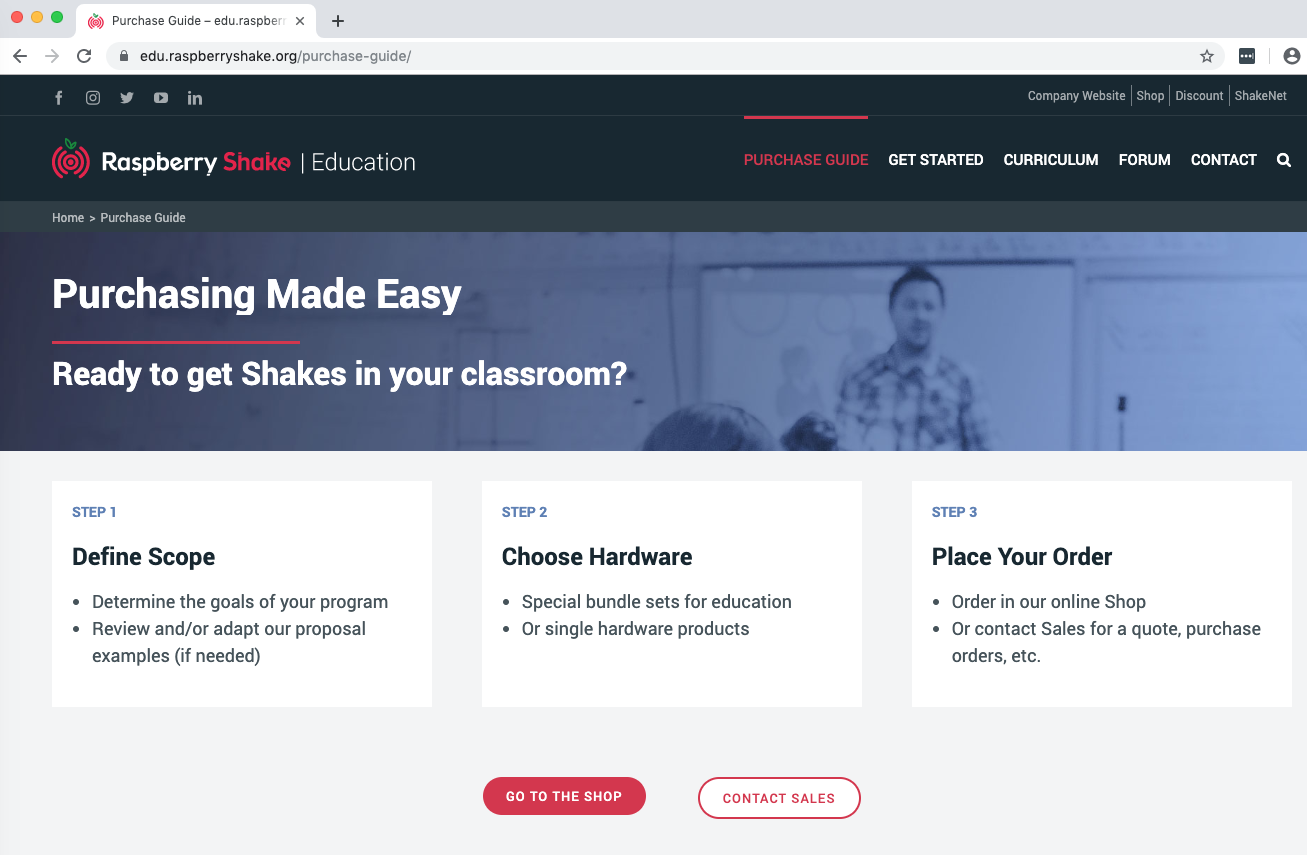
Different programs have different resources and needs depending on many factors (scope, funding resources, etc.) which will all influence your classroom requirements. From the experience we have gained running multiple Shake education programs, we have put together our recommendations and created 3 education “bundles” to meet varying needs.
If funding is an issue, then make sure to check out the Funding Opportunities section. Here we have put together a collection of useful resources and ideas to help. Not only does the page contain links to grants, crowdfunding platforms, and success stories, it also provides access to a 17-page example project proposal for a Raspberry Shake-powered Seismograph in Schools Program! This proposal is completely open-source and can be used in part or in its entirety to help support your educational initiatives.
GET STARTED
After receiving your Shakes and screaming, “Woohoo! Our Shakes have arrived!”, get ready and shaking in no time by following the instructions on this page. Here we will guide you through the setup process as well as introduce you to using your Shake’s data, with these step-by-step videos tailored specifically for educational environments.
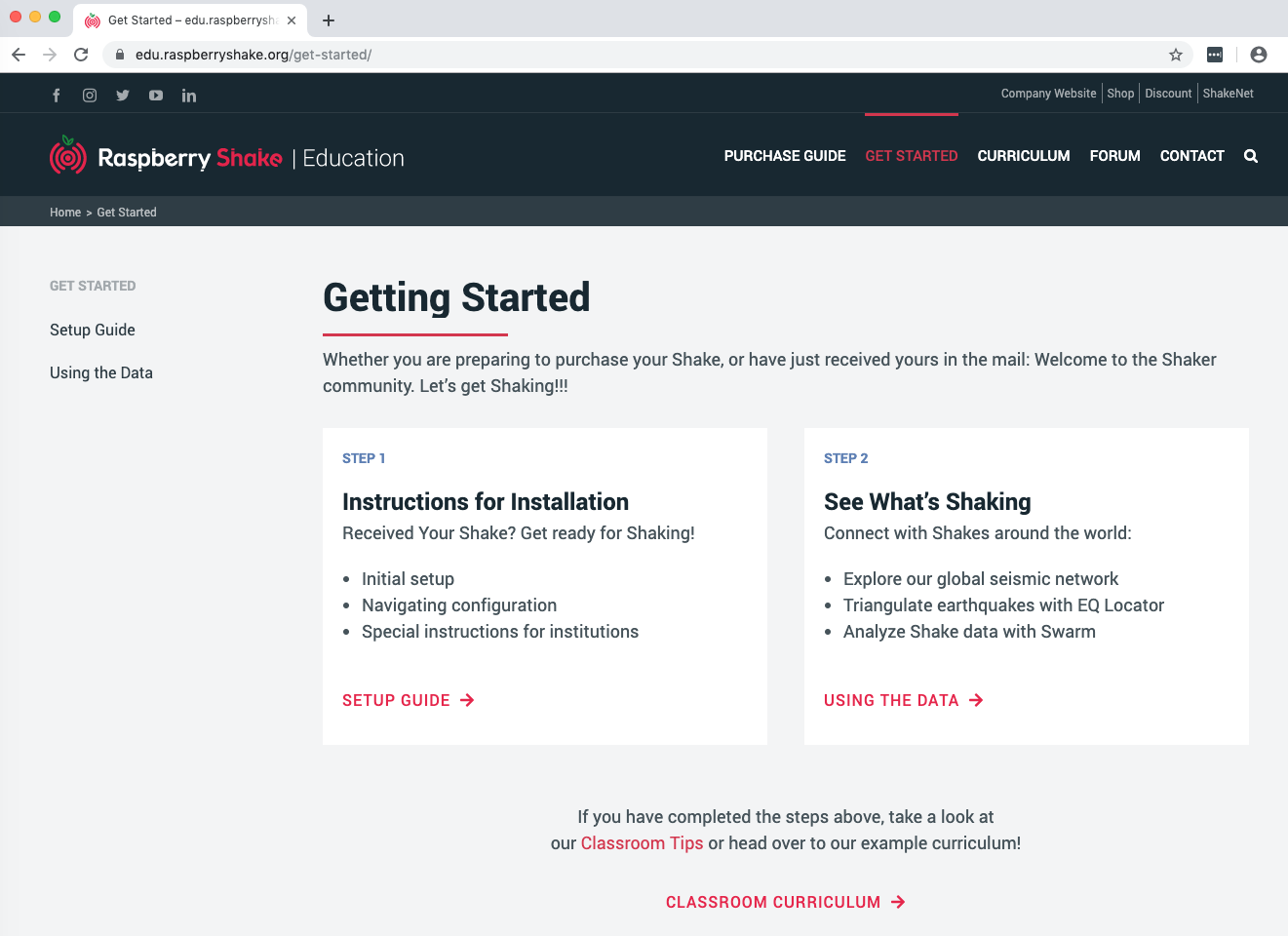
One of the coolest tutorials on this page (although they are all awesome, of course) is the EQ Locator web app tutorial (pictured below). This app is super fun and educational for everyone. Go give it a try at locator.raspberryshake.net! And if you need a tutorial, you know where to find one ?
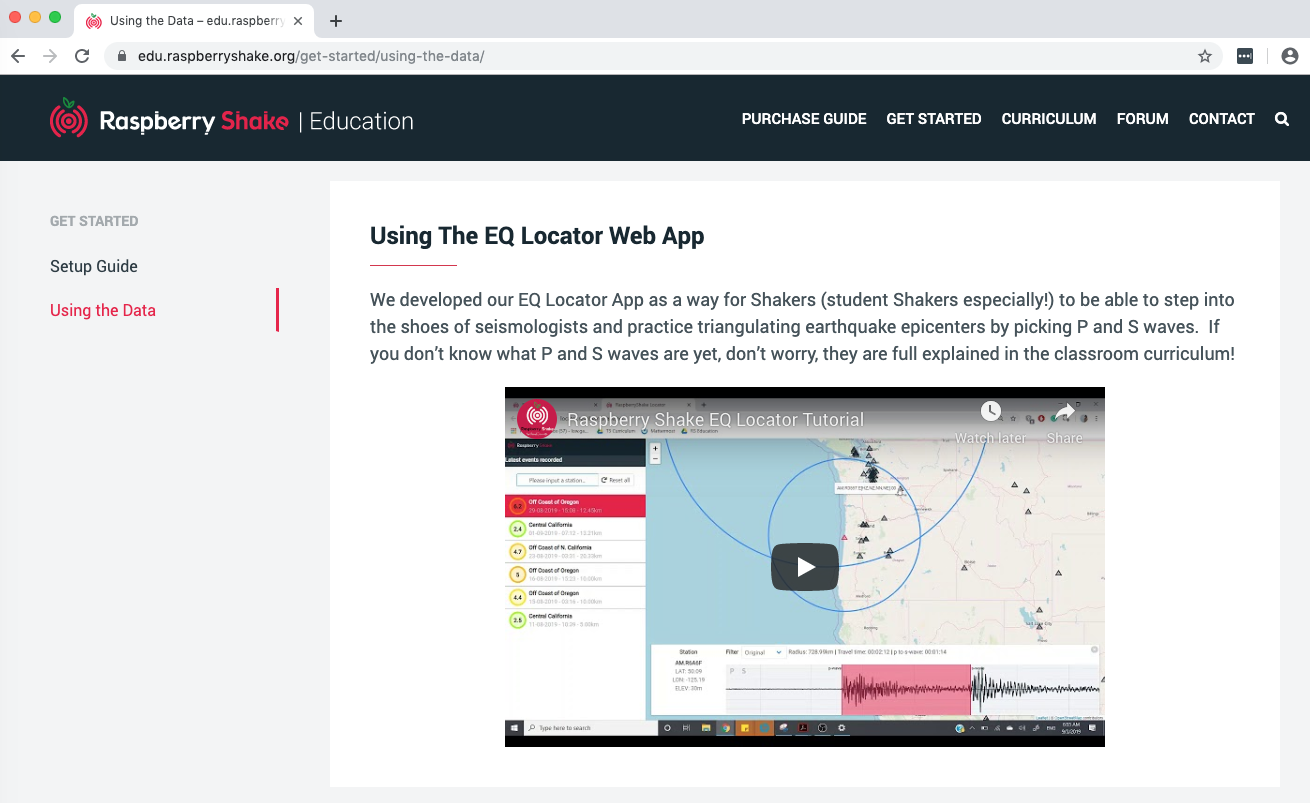
CURRICULUM
The heart and soul of our education website is the curriculum page.
From the conception of this initiative, it was our dream to provide teachers with meaningful, engaging, and accessible instructional materials for implementing Raspberry Shake into their classroom. And now, I can proudly say: We did it!
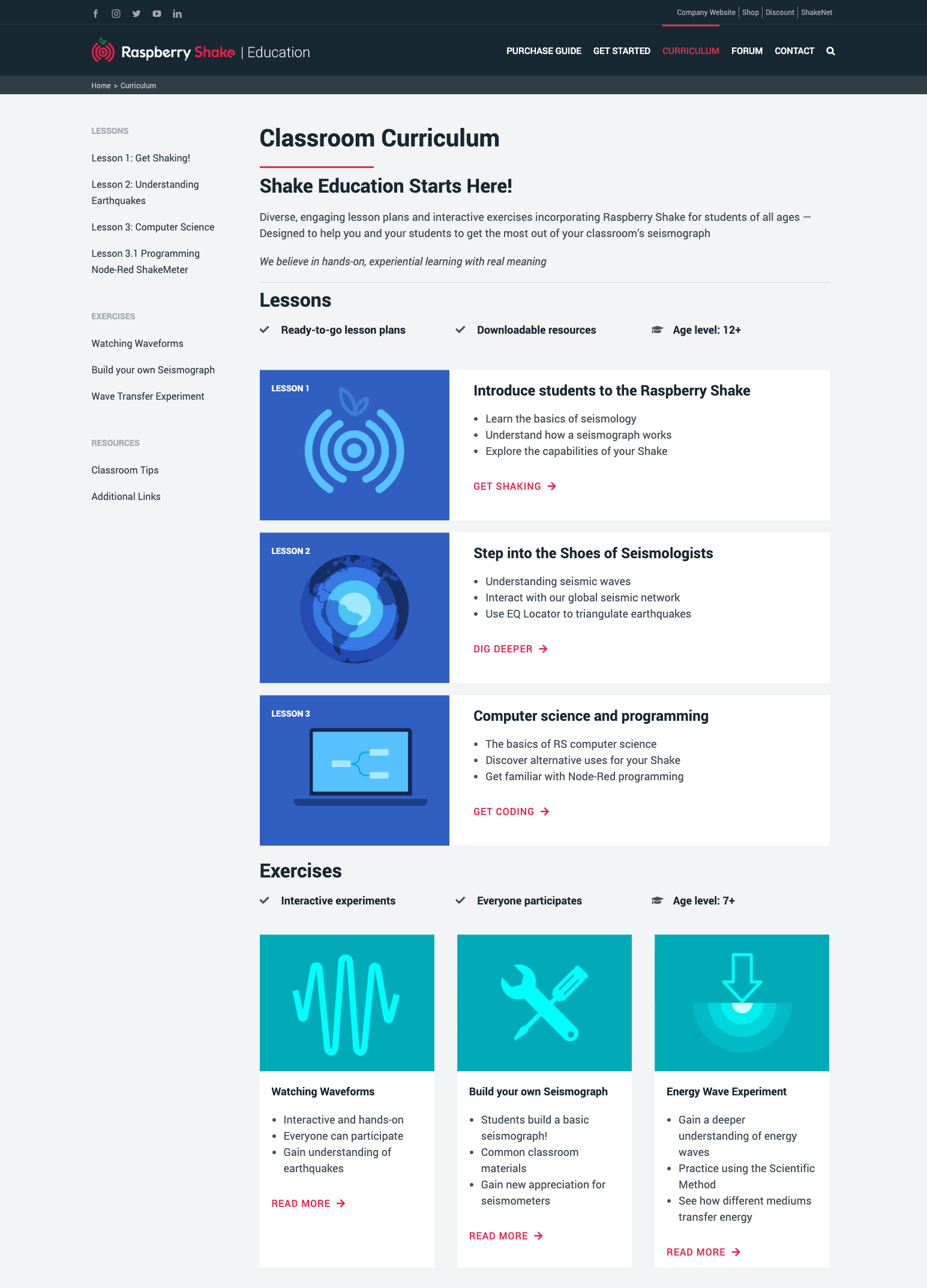
The classroom curriculum is split into two parts: lessons and exercises.
LESSONS
The lessons were designed with the goal of providing students with a strong experiential and theoretical knowledge of seismology, physics, computer science, and more. In our lessons you and your students will explore what makes your little seismograph shake, practice finding the epicenters of earthquakes, program your own “Shakemeter”, and much, much more!
EXERCISES
The exercises are less instructional/theoretical, and more hands-on and interactive. That’s not to say that learning doesn’t occur – on the contrary, students are able to build on theoretical knowledge and really experience physics and science concepts in action.
One of my personal favorites, the Wave Transfer Experiment, explores how waves propagate through different mediums by placing the Shake on top of different materials. How does a waveform change if the Shake is on a concrete floor versus a bag of air? A pillow versus a bag of liquid? Follow the exercise to find out!
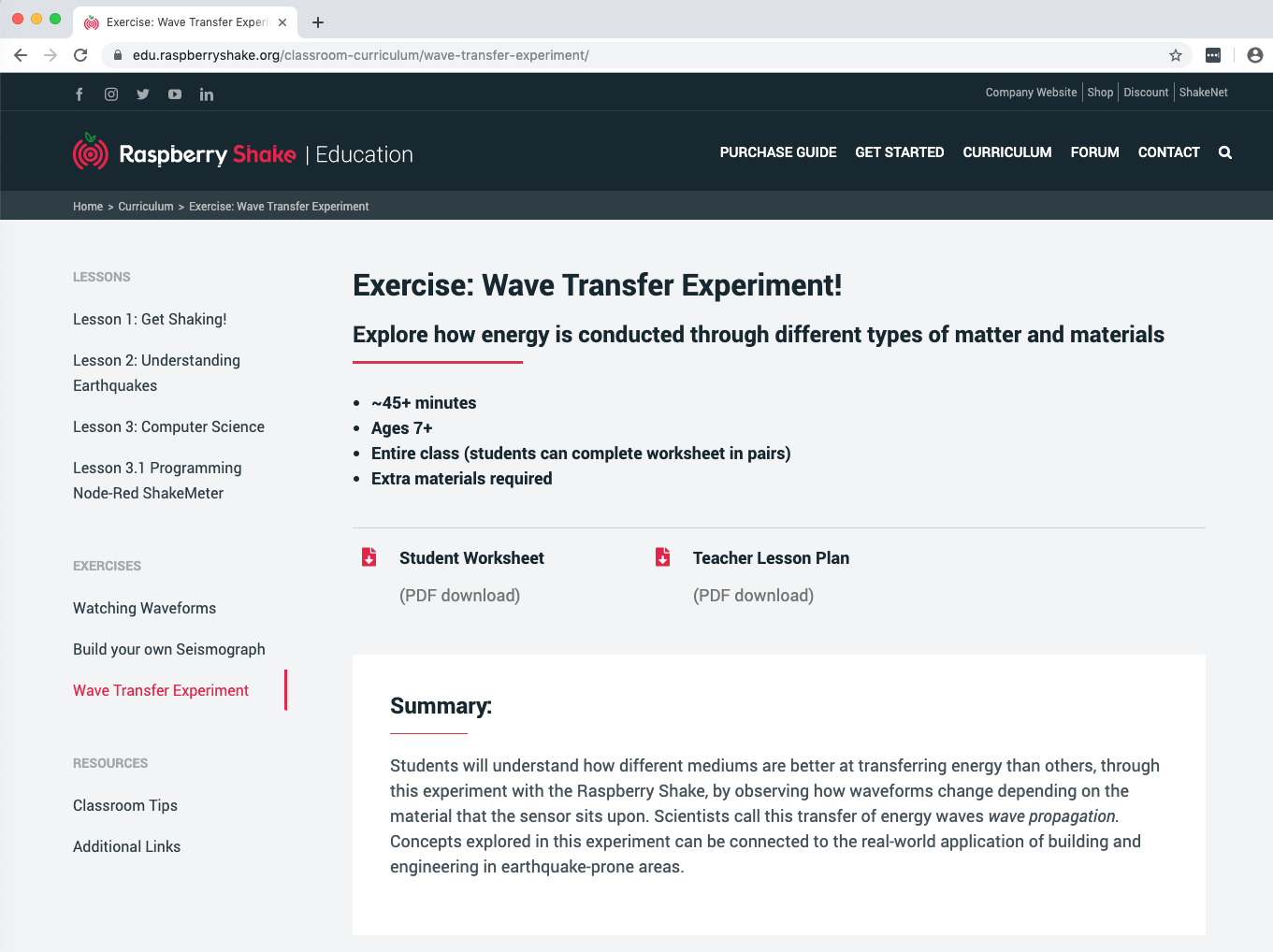
EDUCATION FORUM
Teaching fun-filled interactive STEM lessons with Raspberry Shake is just the first step. As experienced teaching professionals we want to encourage communication and collaboration between you, and our dedicated education forum is a great place for this. Here, teachers and educators from around the world can share curriculum ideas, ask other Shake educators for advice in the classroom, and set up project collaboration ideas. The possibilities are endless!
We welcome you to explore and dig deep into the website and interact with other educators on the forum. For any education-related inquiries please reach out to our team through the site’s contact page.
THANK YOU
THANK YOU to everyone who has helped and collaborated in the development of this site. Not only to our fabulous Raspberry Shake team, but also the many passionate Shakers and Educators who have given their time to help create edu.raspberryshake.org.
A big thank you to Paul Denton of the British Seismology in Schools program, Ben Vanderplujm of University of Michigan, Alan Kafka of the BCESP, Molly Yunker of the Oklahoma Geological Survey and BLOSSM project, Jefferson Chang of the Hawaii Volcanoes Observatory, Shiba Subedi of the Seismology-at-Schools in Nepal program, and many more for their inspiration and insights that went into creating this resource.
We would like to give a special mention to Kristi Fink from the TXESP project, who really went above and beyond in helping us to create this resource by sharing her ideas, thoughts, experience and insights.
Another mention, muy especial, goes to Francheska Gonzales of Upward Bound Sagrado Corazon and Ada Monzon of El Ecoexploratorio, for their support in our “Primer Adiestramiento de Raspberry Shakes en la Educación” training in Puerto Rico. Here we had the opportunity to try out and refine our developing curriculum, as well as raise earthquake awareness to underserved, seismically-at-risk communities.
And, we can’t finish our Thank You’s without a huge shoutout to John Monahan, Roxy Mourant, Adam Low, and the whole T3 Alliance team, who without them, this initiative would have never started. It was almost exactly one year ago, at a T3 Alliance training in Hawaii, where Branden Christensen and I met, and started the conversation about making this dream of an educational resource into a reality. T3 Alliance has been there every step of the way, and our partnership and mutual support will continue to grow and thrive with edu.raspberryshake.org.
We are truly grateful to all of you and are excited to see Shake Education grow and develop, as our little seismographs make it into more classrooms.
At Raspberry Shake, we believe in hands-on, experiential learning with real meaning. We are proud of the amazing stories that have come from Shakes in education so far, and are beyond excited to continue hearing more as this new resource is utilized by Shake educators around the world.
Schools, universities, teachers, students, community members, service clubs, outreach programs, and anyone who could be interested in Shake learning — this resource is for you! Please help us spread the word by sharing edu.raspberryshake.org.
Together, let’s Shake-up Education!
COLLABORATIONS AND PROGRAMS
T3 Alliance – Teaching Through Technology (T³) Alliance is an adaptable curriculum with a comprehensive instructor support system that can be widely adapted to increase the STEM interest of high school students, emphasizing the empowerment that comes from students getting involved in community projects.
OGS BLOSSM – BLOSSM is a geoscience outreach program which is placing 100 Raspberry Shake seismographs into K-16 educational institutions, and public learning spaces such as museums and libraries in Oklahoma. Their goal is to promote integrated curriculum opportunities through the use of this educational technology, while expanding their seismic network.
BGS SIS – The British Geological Survey’s school seismology project enables schools to detect signals from large earthquakes happening anywhere in the world using classroom seismographs.
TXESP – TX-ESP promotes inquiry-based learning and investigative methods in earth sciences for K-12 classrooms. The project often incorporates Raspberry Shake seismographs into their classroom lesson plans.
BCESP – The BC-ESP uses seismology as a medium for inviting students into the world of science research by inquiry-based learning through investigation of earthquakes recorded by seismographs located in K-12 and college classrooms.
Seismology at School in Nepal – The Seismology-at-school project installs low-cost Raspberry Shake seismometers in Nepali schools. These are used as tools to teach students, through whom the entire society can be reached. The seismological data recorded by the school network will be used to detect and confirm earthquakes, and to create shaking maps for significant events.
StIRRRD SIS – Seismometers in Schools is an education initiative already present which involves installing Raspberry Shake seismometers in schools as tools to increase awareness of seismic hazards and risks in Indonesia.
